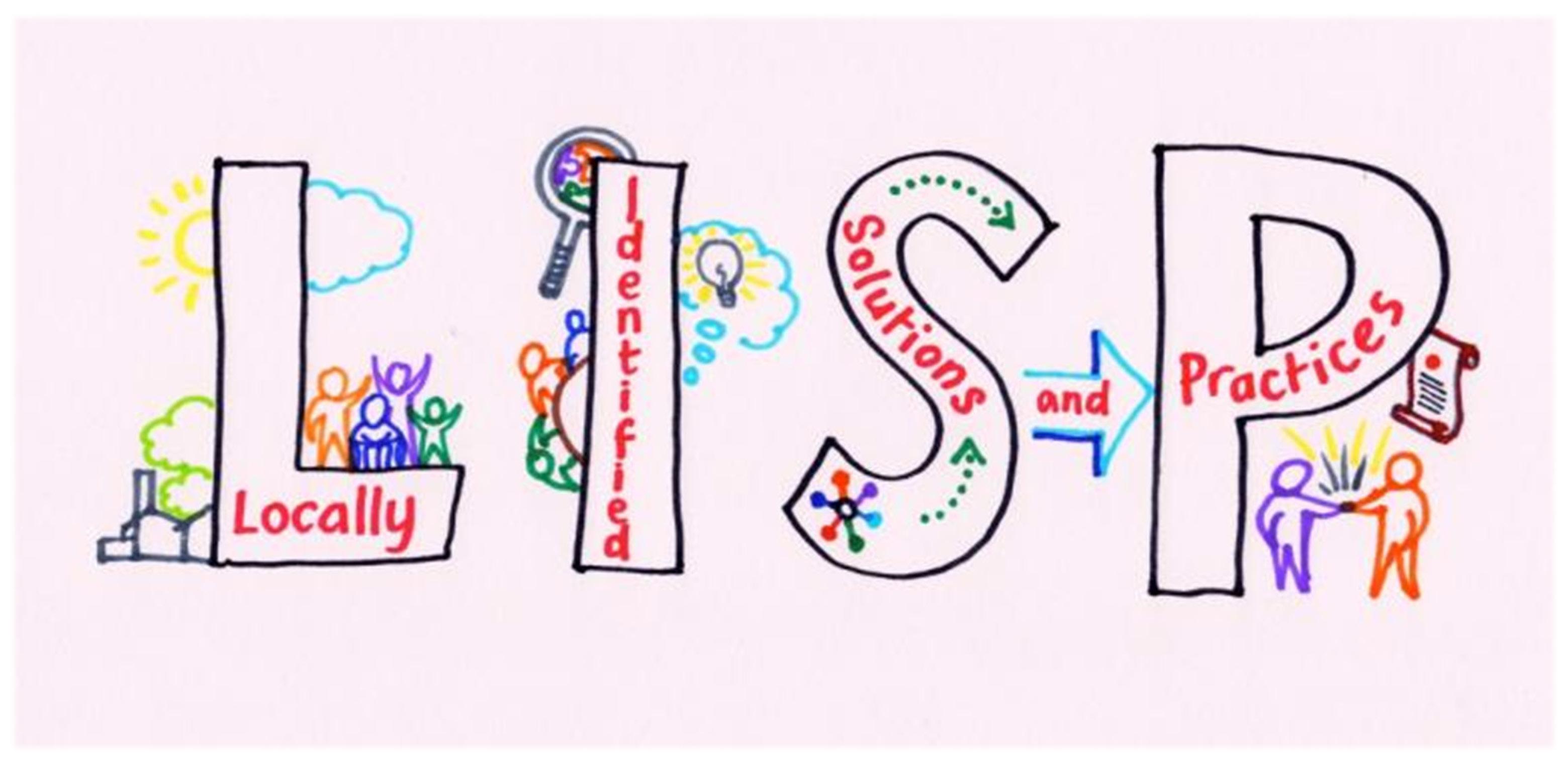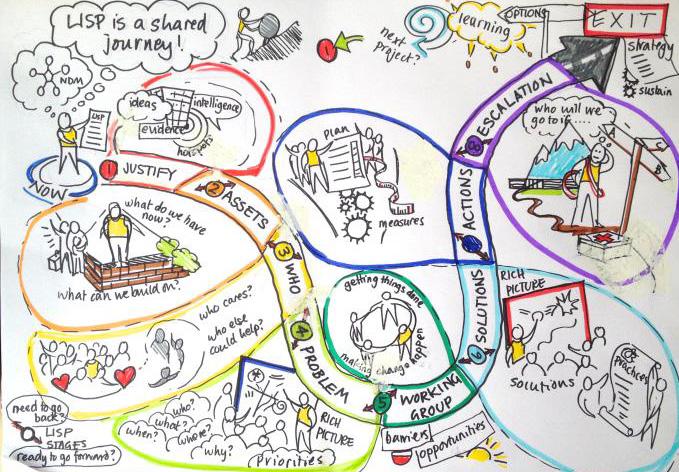
5 minute read
LOCALLY IDENTIFIED SOLUTIONS AND PRACTICES: a guide to Intensive Engagement
from Locally Identified Solutions and Practices: Intensive Community Engagement 2nd Ed.
by Tim Curtis
By Tim Curtis,
Amy Bowkett and Jack Stevens, , with Richard James
Advertisement

Illustrations by Laura Brodrick
INTRODUCTION
This quote from Jeff Conklin nicely describes the challenge of continuing to improve neighbourhood and community-based policing beyond the successes of community safety partnerships. At a time when local authorities, health trusts and development agencies, who are partners to the Police in any given locality, are experiencing severe spending cuts, the complexity of reducing crime and the causes of crime become ever more ‘wicked’.

This toolkit outlines a set of activities that can be led by community practitioners to shift away from locally identified problems to developing, in collaboration with community members, Locally Identified Solutions and Practices (LISP). This approach is a response to the observation that there continues to be a mismatch between the community’s perceptions of crime, and actual crime incidents. It also further reinforces the Peelian principle that the police are citizens in uniform and therefore their decision-making processes within localities should be made with all groupings of residents, rather than ‘on behalf of’. The activities outlined in this toolkit are designed to help the practitioner investigate and thoroughly analyse problems in the locality, with the active involvement of residents and other community stakeholders, to arrive at mutually agreed solutions and practices that reduce the conditions for crime.
Objectives
The objective of the toolkit is to equip public sector practitioners and members of the public to work together towards mutual solutions, the ‘co-production’ of community safety. It is not a process owned by the Police, but rather a way for the Police to help organise other stakeholders to help achieve their goals. It is built around a core strategy of 'rich picturing', which allows communities of which LISP practitioners are a part to explore how each other perceive a community problem and develop joint solutions for the challenges neighbourhoods experience.
The mainstream models of problem solving in policing (the National Decision-making Model (NDM) and Scanning, Analysis, Response, and Assessment (SARA) were designed for problems that are straightforward (although technically difficult), whereas the LISP toolkit is designed to think about, and consult with the public on situations where 'nobody agrees on what the problem is, let alone the solution'. This is known as a 'super-complex problem situation'.
LISP is also a way of encouraging the general public, and community organisations, to be actively involved in solving the problems in their neighbourhood. SARA is a process owned by the Police, whereas LISP is a process shared with the community. Doing a LISP requires intensive engagement with the community to establish networks of capable people working together on a specific problem and devising sustainable practices and behaviours that contribute to community wellbeing and a reduction in crime. The NDM and the LISP models are
5
shown in Figure 1 to demonstrate how they relate to each other. LISP overlays and further develops the basic models.

Figure 1 National Decision Model and LISP
Sustainable practices and behaviours that contribute to community wellbeing and a reduction in crime are collated in an agreed plan -the LISP proforma- where all parties agreed to sustain a set of solutions and practices. This could be a pre-cursor to a full-fledged Neighbourhood Plan. The whole LISP process is based on the principles of collaborative community-based problem solving. The LISP practitioner is guided to become the organiser of anticrime strategies and solutions, rather than being the solver of problems.
Foreword
Welcome to the second edition of the LISP toolkit from Intensive Engagement. It has been thoroughly updated, with significant changes reflecting the ongoing practice and improvements to Intensive Engagement since 2012. The proforma that is used to manage a LISP process has been through several versions, so using the SARA framework for chapter headings seemed too complicated. This edition focusses squarely on the 8 steps that have been introduced and refined in over 10 different LISP projects, both successful and unsuccessful. Material that had been consigned to the back of the book has been brought forward to the main sections, starting with the practical instructions for each step, and then more detailed reading in support of the practice. The training and toolkit is now aligned, and exceeds, the requirements for Problem Solving Skills of the Policing Professional Framework (PPF), although the material is focused on any practitioner working on public safety, no longer necessarily a PCSO or police officer. This work is now based on the experience of training over 500 police officers, PCSOs and local authority staff, and a thorough investigations of 10 detailed cases through PhD and Master’s degree research. The underpinning literature and research evidence has been omitted from this handbook but is available on the Intensive Engagement website.
Tim Curtis
Senior Lecturer, The University of Northampton
6
CHAPTER 1. THE TOOLKIT
LISP is the process of developing locally identified solutions and practices to address the conditions that lead to high levels of chronic crime that affects the public. It is particularly designed for use in areas where there are hotspots of crime (real and perceived) and anti-social behaviour, of which has been going on for a very long time- over several years. It is designed for situations where lots of Police 1 activities have already been tried, but a new approach is thought to be necessary.
It is an 8-step journey (Figure 2) that is shared with the neighbourhood that is the focus of the policing problem. Like all journeys, we can turn back to the early stages and keep ‘circling the block’ until we have properly understood the reasons why a neighbourhood is suffering from high levels of crime. Police & Crime Commissioners, Police forces and Community Safety Partnerships are involved in deciding what crime patterns and issues are most concerning and invest in intensive engagement with the neighbourhood with enough resources to catalyse and kick-start self-sufficient responses to reduce the possibility of crime. The Police forces themselves can’t and won’t deliver all the solutions, so community partners need to be galvanised to allow the Police and statutory partners to take a step back, freeing up Police resources for use in other areas.


Figure 2 Intensive Engagement 8 steps
1 The word Police with a capital P denotes the official Police force and their staff. Small ‘p’ policing refers to the work that all citizens engage in to keep themselves and their neighbours safe.
Figure 3 LISP is a shared journey
7

